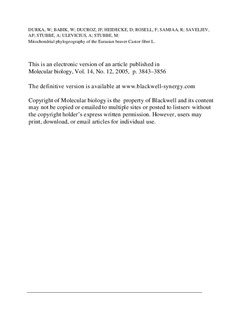Mitochondrial phylogeography of the Eurasian beaver Castor fiber L.
Durka, Walter; Babik, Wieslaw; Ducroz, Jean-Francois; Heidecke, Dietrich; Rosell, Frank; Samjaa, Ravcigijn; Saveljev, Alexander P.; Stubbe, Annegret; Ulevicius, Alius; Stubbe, Michael
Journal article, Peer reviewed
Permanent lenke
http://hdl.handle.net/11250/2438022Utgivelsesdato
2005Metadata
Vis full innførselSamlinger
Originalversjon
Molecular biology 14 (2005), No. 12, p. 3843??856 http://dx.doi.org/10.1111/j.1365-294X.2005.02704.xSammendrag
Nucleotide variation in an approximately 490 bp fragment of the mitochondrial DNA control region (mtDNA CR) was used to describe the genetic variation and phylogeographical pattern in the Eurasian beaver ( Castor fiber ) over its entire range. The sampling effort was focused on the relict populations that survived a drastic population bottleneck, caused by overhunting, at the end of the 19th century. A total of 152 individuals grouped into eight populations representing all currently recognized subspecies were studied. Sixteen haplotypes were detected, none of them shared among populations. Intrapopulation sequence variation was very low, most likely a result of the severe bottleneck. Extreme genetic structure could result from human-mediated extinction of intermediate populations, but it could also be an effect of prior substantial structuring of the beaver populations with watersheds of major Eurasian rivers acting as barriers to gene flow. Phylogenetic analysis revealed the presence of two mtDNA lineages: eastern (Poland, Lithuania, Russia and Mongolia) and western (Germany, Norway and France), the former comprising more divergent haplotypes. The low level of sequence divergence of the entire cytochrome b gene among six individuals representing six subspecies suggests differentiation during the last glacial period and existence of multiple glacial refugia. At least two evolutionary significant units (ESU) can be identified, the western and the eastern haplogroup. The individual relict populations should be regarded as management units, the eastern subspecies possibly also as ESUs. Guidelines for future translocations and reintroductions are proposed.
